In 2019, comedian Kaneez Surka opened up about a dissatisfactory sexual experience that she had with someone. In the video she narrated how her sexual partner, upon hearing from her that she hadn’t had an orgasm, said, “I’ll go on and let you finish it.” Surka might be among the very few Indian women who actually voiced her dissatisfaction in bed. According to a popular survey, 70 percent of Indian women fake their orgasms. Surka, in the video, said she’d considered faking the orgasm but decided instead to voice the sexual inequality, even if it didn’t lead to the pleasurable results.
Faking orgasms is not new. In fact, an extensive study conducted by scientists Gayle Brewer of the University of Central Lancashire and Colin Hendrie of the University of Leeds in 2009 concluded that up to 80% of heterosexual women fake orgasms with their partners. If this sounds like a familiar story to you, there are many reasons why.
Several psychologists say that faking orgasms is “easier” than communicating to male partners about their sexual desires because men tend to either not care about their partner’s pleasure or women are afraid of finding out that their

pleasure didn’t matter to their partner. It could leave many women shocked and hurt, as was the case with Surka.
The fact that faking orgasms is so common highlights a larger social issue of the ‘pleasure gap.’ According to social research, women are four to five times likelier to say that they did not have pleasurable, satisfying sex in the past year than men. Cis heterosexual men are 20 to 50% likelier have had orgasms before their female partner did.
The pleasure gap essentially highlights how women tend to have less satisfactory sexual experiences than men do. In a country where talking about sex openly is considered taboo and where school children are not provided adequate anatomy education, idea of female pleasure is not only ignored, it is downright discouraged. Most heterosexual men are raised to put their needs first and have a difficult time unconditioning themselves from the selfishness of not caring about their partner’s needs in bed. They also face a lot of difficulty communicating with their partner about their partner’s pleasure. Campaigns on spreading clitoral literacy or ‘cliteracy’ only reflect how little Indian men are educated on the female sexual anatomy.

As the lockdown transitioned into a prolonged period of staying at home and intimacy permanently changed while we dealt with a different world, female pleasure became a larger topic of conversation. From influencers and gynecologists to self-pleasure advocacy groups on Instagram, female orgasms, anatomy education and self-pleasure took over many virtual spaces.
Perhaps it was the safety of being at home and the perceived anonymity of the internet that helped women come forward and talk about their experiences in self-pleasure. Either way, virtual safe spaces discussed the importance of female
THE SURVEY STATES:
“On a spectrum ranging from dirty, disgusting and violent to hot, wonderful and erotic, a lot of women and men leaned towards hot and erotic. But quite a few women used violent, dirty and disgusting words to describe porn. This is not surprising, because for years now, porn has been made by men, for men, where women are only seen as pleasure givers. While there is certainly more porn being made for women, and there has also been a rise in the number of women making porn, there is still a huge gap between demand and supply.”
However, not all is lost. With increasing awareness about sexual health and literacy, and with more and more pleasure brands introducing pleasure toys and pleasure products in the market, the opportunity to bridge the pleasure gap is beginning to widen. Katherine Rowland, the author of The Pleasure Gap: American Women and the Unfinished Sexual Revolution, spoke to 1000s of American women to highlight the cultural inequality of the orgasm gap. Even though her research centres around American sexual health, her ideas around how to bridge this gap has an important lesson for all women. While the onus of treating women in bed as an equal in pleasure certainly lies on hetereosexual men, speaking up and rejecting ideas that women should settle for diminished pleasure should be thrown out the window. As she says in the book, “Women should take inequality in the bedroom as seriously as we take it in the boardroom and understand its causes and effects.”










